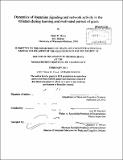Dynamics of dopamine signaling and network activity in the striatum during learning and motivated pursuit of goals
Author(s)
Howe, Mark W. (Mark William)
DownloadFull printable version (18.47Mb)
Other Contributors
Massachusetts Institute of Technology. Department of Brain and Cognitive Sciences.
Advisor
Ann M. Graybiel.
Terms of use
Metadata
Show full item recordAbstract
Learning to direct behaviors towards goals is a central function of all vertebrate nervous systems. Initial learning often involves an exploratory phase, in which actions are flexible and highly variable. With repeated successful experience, behaviors may be guided by cues in the environment that reliably predict the desired outcome, and eventually behaviors can be executed as crystallized action sequences, or "habits", which are relatively inflexible. Parallel circuits through the basal ganglia and their inputs from midbrain dopamine neurons are believed to make critical contributions to these phases of learning and behavioral execution. To explore the neural mechanisms underlying goal-directed learning and behavior, I have employed electrophysiological and electrochemical techniques to measure neural activity and dopamine release in networks of the striatum, the principle input nucleus of the basal ganglia as rats learned to pursue rewards in mazes. The electrophysiological recordings revealed training dependent dynamics in striatum local field potentials and coordinated neural firing that may differentially support both network rigidity and flexibility during pursuit of goals. Electrochemical measurements of real-time dopamine signaling during maze running revealed prolonged signaling changes that may contribute to motivating or guiding behavior. Pathological over or under-expression of these network states may contribute to symptoms experienced in a range of basal ganglia disorders, from Parkinson's disease to drug addiction.
Description
Thesis (Ph. D. in Neuroscience)--Massachusetts Institute of Technology, Dept. of Brain and Cognitive Sciences, 2013. Cataloged from PDF version of thesis. "February 2013." Includes bibliographical references (p. 118-126).
Date issued
2013Department
Massachusetts Institute of Technology. Department of Brain and Cognitive SciencesPublisher
Massachusetts Institute of Technology
Keywords
Brain and Cognitive Sciences.